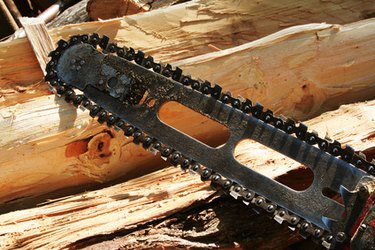Things You'll Need
Chainsaw
Axe
Protective eyewear and gloves

Russian olive trees were recommended for many years as natural windbreaks, but have fallen out of favor in recent years. Some find their odor offensive, while leaves and fruits are messy. In natural settings, they quickly become invasive, crowding out other native species. They are considered noxious plants in some states, such as Colorado. In these states, selling or planting them is often illegal. Using Russian olive trees as firewood is a good way to consume unwanted trees, with a few caveats. The wood is dense and difficult to cut, and the bark is very coarse and uneven, making stacking a challenge.
Felling the Tree
Step 1
Clear the brush around the Russian olive tree and plan an escape route.
Video of the Day
Step 2
Cut a horizontal cut one-third of the way through the trunk with the chainsaw. Make this cut 12 to 18 inches from the ground on the side of the tree you want to hit the ground first.
Step 3
Make another cut at a 45-degree angle above the original cut, so the cuts join, creating a notch in the wood resembling a wedge of watermelon.
Step 4
Make a horizontal cut with your chainsaw through the opposite side of the tree 1 to 2 inches above the original cuts. As the chainsaw reaches the middle of the tree, the tree will begin to fall due to the hinge you originally cut.
Step 5
Step away from the tree at a 45-degree angle once it starts to fall.
Preparing the Firewood
Video of the Day
Step 1
Cut off the limbs with your chainsaw. Remove the limbs from the bottom of the trunk first, followed by the top limbs, advises the University of Nebraska Lincoln Extension website. The limbs in the middle of the tree usually rest on the ground, providing stability. Remove them last to prevent the tree from rolling.
Step 2
Cut the trunk into pieces about 4 inches smaller than your wood box.
Step 3
Cut the wood by splitting it with an axe or log splitter. Russian olive wood tends to warp and crack as it splits. Split each log into two to four pieces, depending on the log size.
Step 4
Stack the wood in a dry, protected area. The gnarled, twisted nature of this wood makes creating a tidy stack of wood difficult. A wood box helps contain it.
Step 5
Season the wood to remove any moisture for one year before burning it.
Burning Russian Olive Wood
Step 1
Hit the wood against the wood box or ground before bringing it indoors. The dense, deeply creviced bark makes a perfect hideout for spiders and insects.
Step 2
Lay small pieces of Russian olive wood in the fireplace with other types of wood.
Step 3
Build the fire slowly, using a combination of Russian olive wood and faster-burning wood, such as pine.
Tip
Russian olive trees generally have fairly short trunks and many gnarled branches. They don't produce as many large pieces of firewood as taller tree varieties, but the branches make good kindling.
Russian olive wood produces an unpleasant odor when green. It also won't burn and will produce excess smoke. Don't burn it until it has seasoned for at least one year. Russian olive wood burns very slowly. Fires made solely with this wood are difficult to start. Use a combination of woods instead.
Warning
The short trunk and gnarled branches of these trees gives an impression of light wood, but don't be deceived. Russian olive trees are very heavy. Take care when cutting them and work with a partner.